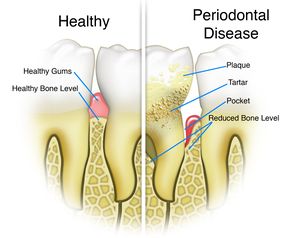User:S4342592: Difference between revisions
| Line 35: | Line 35: | ||
===biofilm formation=== | ===biofilm formation=== | ||
Dental plaque develops on tooth surfaces and in certain circumstances it progresses to a more pathogenic condition such as periodontal diseases. The process of plaque build-up is characterised by binding interactions of various oral bacteria. Early, primary commensal colonisers such as oral streptococci attach to the enamel pellicle, covering the tooth surface and providing attachment sites for subsequent colonisation by other potential pathogenic bacteria such as ''P. gingivalis''. Evidently, together with ''Streptococcus gordonii'', ''P. gingivalis'' is able to colonise efficiently, making it an important process in biofilm formation. | Dental plaque develops on tooth surfaces and in certain circumstances it progresses to a more pathogenic condition such as periodontal diseases. The process of plaque build-up is characterised by binding interactions of various oral bacteria. Early, primary commensal colonisers such as oral streptococci attach to the enamel pellicle, covering the tooth surface and providing attachment sites for subsequent colonisation by other potential pathogenic bacteria such as ''P. gingivalis''. Evidently, together with ''Streptococcus gordonii'', ''P. gingivalis'' is able to colonise efficiently, making it an important process in biofilm formation <sup>[[#References|[]]]</sup>. | ||
===metabolic functions=== | ===metabolic functions=== | ||
Revision as of 03:08, 23 September 2016
Nur' Amirah Mohd Kassim Bench D 09082016
Classification
Higher order taxa
- Kingdom: Bacteria
- Domain: Bacteria
- Phylum: Bacteroidetes
- Class: Bacteroidia
- Order: Bacteroidales
- Family: Porphyromonadaceae
- Genus: Porphyromonas
Species
Porphyromonas gingivalis strain 2561 = ATCC 33277= CCUG 25893 = CCUG 25928 = CIP 103683 = DSM 20709 = JCM 12257 = NCTC 11834.

Description and significance
Porphyromonas gingivalis is a gram negative, non motile, rod shaped bacteria that is pathogenic, with no functional role [1]. It is commonly found in the oral cavity[2]. On blood agar plate, it forms black pigmented colonies [3]. P. gingivalis is the main source of periodontal disease and is also said to be associated with cardiovascular disease and diabetes amongst other inflammatory disease thus it is important to study this bacterium, to help reduce the risk of more serious illnesses [4].
Examples of citations [1], [2]
Genome structure
In 2003, the genome of P. gingivalis was described to have 2,343,479bp with an average guanine cytosine nucleotide content of 48.3%. It has 4 ribosomal operons, 2 RNA structural genes and 53 tRNA gene. There was a total of 1990 open reading frames that could be identified in the genome. 21 areas of the genome were discovered to display an atypical nucleotide composition. The areas range in size from 11 to 68kb and has a guanine cytosine nucleotide content of between 29.4% to 61.6%. 463 genes were also seen in the genome [5][6]
Cell structure and metabolism
Cell wall
biofilm formation
Dental plaque develops on tooth surfaces and in certain circumstances it progresses to a more pathogenic condition such as periodontal diseases. The process of plaque build-up is characterised by binding interactions of various oral bacteria. Early, primary commensal colonisers such as oral streptococci attach to the enamel pellicle, covering the tooth surface and providing attachment sites for subsequent colonisation by other potential pathogenic bacteria such as P. gingivalis. Evidently, together with Streptococcus gordonii, P. gingivalis is able to colonise efficiently, making it an important process in biofilm formation [].
metabolic functions
Ecology
P. gingivalis is an anaerobic rod shaped microorganism that is mainly found in the subgingival plaque of the periodontal in the oral cavity. Other potential environment where the pathogenic bacteria can be found include the upper gastrointestinal tract, the colon and the respiratory tract []. it has also been found in women with bacterial vaginosis []
Microbe/Host interactions

Pathology
P. gingivalis is responsible for causing periodontal disease. Periodontal disease is characterized by the destruction of tooth supporting tissues due to complex polymicrobial infection. The disease progresses from acute inflammation of the gingival tissue to formation of tooth pockets which eventually leads to the loss of teeth.
Other than causing periodontal disease, the microorganism is said to also cause rheumatoid arthritis.
Application to biotechnology
Bioengineering, biotechnologically relevant enzyme/compound production, drug targets,…
Current research
Summarise some of the most recent discoveries regarding this species.
References
References examples
This page is written by Nur' Amirah Mohd Kassim for the MICR3004 course, Semester 2, 2016
